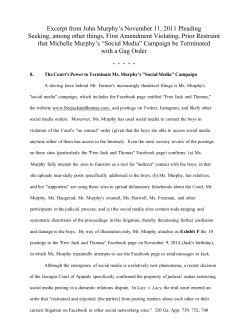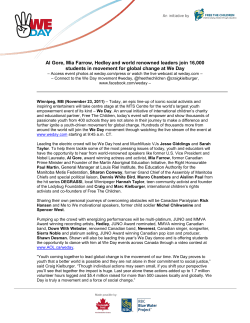
© Are Women Persons A Paper Presented to by
Are Women Persons? : The Case of Canada’s Famous Five A Paper Presented to The Religious Education Association November 4, 2011 Toronto, Ontario, Canada by © Professor Lorna M.A. Bowman Brescia University College at The University of Western Ontario London, Ontario, Canada Are Women Persons? The recognition of women’s full personhood under the law in Canada dates to a struggle begun in the 1800s in Britain culminating in the 1929 ruling by the Judicial Committee of the Privy Council of the British Parliament on Canada’s Persons Case. This paper finds its context in Canada’s history as a British colony. Its focus is the Persons Case fought by five women their recognition as full persons under the law. Their actions reflect the formative influence of the Canadian Social Gospel movement. The Dominion of Canada 1867-1982 The colonizers of present day Canada were Britain and France. In 1867, the British Parliament created the Dominion of Canada with the British North America Act (BNA Act) as Canada’s constitution. Canada’s Fathers of Confederation envisioned a selfgoverning colony of the Empire with two official languages, English and French. In 1982, Canada repatriated the BNA Act, establishing the Constitution Act, 1982. The BNA Act was included as the Constitution Act, 1867.1 Thus, it was not until 1982 that Canada obtained full self-governance with the power to amend its constitution. (Canadian Encyclopedia) In the early years of the Dominion, the provincial and federal governments fought over issues of jurisdictional authority. Until 1949, such matters of civil law not resolved satisfactorily by the Supreme Court of Canada (established in 1875) could be referred to the British Privy Council. This constitutional provision became a key dimension of the Persons Case. The Social Gospel Movement and Women in Canada From the 1890s to the 1930s the Social Gospel movement was a major force across Canada. Its fundamental vision was societal concerns could be resolved by applying the teachings of Christ. It was the Christian response to Social Darwinism, the nineteenth notion of the struggle for existence used to justify social policies making no distinction between the socially disadvantaged and the privileged. The Social Gospel combined an idealistic view of human nature with the belief that God was at work in social change creating both moral order and social justice. “ [It] . . . developed under the influences of a social concept of man [sic] and underlined the social dimensions of the gospel, so that the solutions that appeared to be most useful were those which had an essentially social character” (Allen, 1975, 4). Thus, the whole problem, not just that of individuals or informal social groups, were addressed through institutional change. (Ibid.) Protestant church leaders in the Social Gospel movement paid little attention to women’s suffrage and rights but by 1912 one out of every eight belonged to a women’s group. The presenting impetuses were the changing social conditions due to the industrial revolution, increased immigration, and the lack of legal protection for women and families. Alcohol abuse, desertion by husbands, appropriation of female wages and property by males heads of families, and domestic violence were common. Diverse women’s groups promoted temperance and prohibition, universal suffrage, social purity (against prostitution), the 2 defense of the family and the rights of married women, health, housing and educational and church reform. According to Richard Allen, the Canadian Social Gospel movement was “primarily . . . a religious and intellectual movement” (11). This period saw a revivalism across Canada that evangelicalized much of Canadian Protestantism. (Ibid.) The leaders in the women’s movement were middle-class Anglophones, well-educated and Protestant. The struggle for women’s suffrage was fought both provincially and federally.2 In 1918, female citizens of European ancestry only, aged 21 and older, received the vote federally whether or not they had the provincial franchise.3 In Canada, the Woman’s Christian Temperance Union (WCTU) was founded in 1874 in Owen Sound, Ontario.4 Through the work of Louise McKinney, one of the Famous Five, it grew across Canada. Women sought the franchise both as an expression of their unique maternal role and as a matter of natural justice, believing it was a necessity for social reform of the male-privileged society. In Western Canada the suffragists were often perceived as subversive: When women were campaigning to receive the vote in the early 1900s [in Western Canada], their suffrage meetings were frequently disrupted by opponents. Many women were forbidden by their husbands or fathers to attend these meetings, and others simply did not have the confidence to do so because of the strong, chaotic opposition. Pink Teas were developed as a way for [frontier] women to gather and discuss various issues of importance including suffrage. Only women were invited, and frilly decorations and many pink doilies festooned the tea tables. Only the organizer of the Pink Tea knew if there would be a formal discussion on strategies to obtain the vote or just pleasant conversation so, if opposition appeared, the organizer could change the subject! (Famous Five Foundation) 5 Language and Personhood The King James translation of the Bible profoundly influenced education, spoken language, literature, and the religious and popular imagination of all English-speaking peoples. The singular “man” became understood as inclusive of “women.” “It was in the language and substance of religion that nineteenth century [persons] pondered the meaning of their individual and public experience” (Cremin, 1980, 7). Until the second wave of feminism in the 1970s, this male-gendered language became the norm in popular discourse when speaking of both women and men.6 Such language became a key issue in the Persons Case. Canada’s Famous Five The five women responsible for Canada’s Persons Case were Emily Murphy, Henrietta Muir Edwards, Louise McKinney, Irene Parlby and Nellie McClung. Pegged as the “Famous Five” by English newspapers in the 1920s (Benoit, 2000), all migrated to 3 Alberta, the last frontier to be settled in North America. Migrants from Eastern Canada as well as Europe and the United States travelled West to participate in the development of the vast fertile lands of the prairies. Harsh winters, with temperatures of -50̊ Celsius or 70̊ Fahrenheit and primitive isolated housing made life difficult, particularly for poorer rural women and children. Responding, to such conditions each of the Famous Five worked for social reform. Among the first females in the British Empire to hold public office, their accomplishments reflect the Canadian Protestant women’s activism. (Millar, 1999; Benoit, 2000; Famous Five Foundation, 2009) Emily G. Murphy (1868-1933) was a writer and journalist, a suffragist and the first woman magistrate in the Empire. She pioneered women’s rights, was the National President of the Canadian Women’s Press Club, vice-president of the National Council of Women of Canada and the first president of the Federated Women’s Institutes of Canada. Henrietta Muir Edwards (1849-1933) was a journalist and suffragist as well as a grassroots organizer who fought for equal rights for wives, mothers’ allowances, and women’s rights. In 1875, she started the Working Girls’ Association in Montreal, a forerunner of the YWCA; in 1893, she was a founding organizer of the National Council of the Women of Canada, becoming Convenor of Laws until her death sixty years later. After migrating to Alberta, she published a federal government handbook on the legal status of women in Canada as well as a similar provincial publication on Alberta’s laws affecting women and children. At the age of 80, Edwards was the lead signatory in the Persons Case. Louise McKinney (1868 -1931) was a temperance campaigner, suffragist and organizer with the WCTU and politician. She was president of the Dominion WCTU, and elected to the Alberta legislature in 1917, the first woman to sit in a legislature in the British Empire. In 1917, she won the first Dower Act in Alberta. This had first been worked on by Emily Murphy and Henrietta Muir Edwards in 1910-11 but had resulted in Alberta’s less comprehensive 1915 Married Woman’s Home Protection Act. When the United Church of Canada was formed, Edwards was the only woman from Western Canada to sign the 1925 Basis of Union. Irene Parlby (1878-1965) was a suffragist and politician. She advocated for an independent association of farm women in 1916 and was elected first president of the United Farm Women’s Association. In 1920, Parlby was named a governor of the University of Alberta. She became a member of the Alberta legislature in 1921, later becoming the second female cabinet member in the British Empire. At the time of the Persons Case, she was a provincial member of Parliament. In 1931, she was named first vice-president of the World WCTU. Nellie L. McClung (1873-1951) was a journalist, suffragist, temperance worker and novelist. In 1918, she advocated for women’s ordination in the Methodist Church and became a member of the Alberta legislature in 1921. She was the first female director of the Board of Governors of the Canadian Broadcasting Corporation and a delegate to the League of Nations in 1930. 4 The Famous Five are sometimes referred to as maternal feminists, women whose role as a mother carried with it the obligation to participate in the public sphere as mothers. While women at the time often viewed their roles as complementary to those of me, it is more accurate to describe them as first wave feminists.7 “The distinction between the maternal and egalitarian argument [for their work] was not always spelled out in McClung’s thinking or in that of many of her contemporaries” (Strong-Boag, 1997, 3). Above all else, they were social reformers with vocational priorities informed by Gospel sensibilities. The Persons Case The Persons Case, known formally as Edwards v. Attorney General of Canada, is renown in Canadian constitutional law. Emily Murphy was the leader but the Famous Five together provided the Christian commitment, expertise, credibility and social networks needed. In 1916, the Attorney General for Alberta appointed Murphy as “‘Police Magistrate in and for . . . Alberta, and . . . Commissioner under the Children’s Protection Act’”(Cited in Sharpe & McMahon, 2009, 20-21). On her first day in court, Murphy’s ability to act as a judge was challenged by defence counsel on that grounds that women were not persons as defined in the constitution. Murphy ruled him out of order, demanded an apology and continued. His argument was based upon an obsolete decision rendered in 1876 in Britain, which had never been overturned, stating “Women are persons in matters of pains and penalties, but are not persons in matters of rights and privileges” (McClung, 1845, 186, cited in Benoit, 2000). The seed of Emily Murphy’s conscientization was sown; she began to raise the consciousness of others with respect to the barring of women from public office. Section 24 of the BNA Act stated that only “qualified persons” could be appointed to the Senate. In 1919, Murphy, as first elected president of the Federated Women’s Institutes of Canada, proposed a resolution for the appointment of women to the Senate that was adopted and forwarded to the Federal Minister of Justice. The same year the Montreal Women’s Club nominated her for the Senate. Support mushroomed across Canada. More than 10,000 citizens signed petitions and wrote letters of support for Murphy’s cause. When a Senate seat for Alberta became vacant, Prime Minister Borden responded that the constitution did not permit him to appoint a woman. Four ensuing federal governments (1920 – 1927) expressed support for such appointments; two promised to change the law. One of Murphy’s brothers brought Section 60 of the Supreme Court Act of Canada to her attention. It permitted five persons acting as a unit to ask for an interpretation of any part of the BNA Act. Murphy chose Edwards, McClung, McKinney and Parlby as her coappellants. In 1927, the women met at Murphy’s home for a Pink Tea to sign a petition to Prime Minister MacKenzie King’s government. Murphy’s wording posed the question positively because the Crown had declared that women were not “qualified” persons: “As persons interested in the admission of women to the Senate of Canada we do hereby request that you may be graciously pleased to refer to the Supreme Court 5 of Canada for hearing, consideration and adjudication the following constitutional questions: I. Is power vested in the Governor General of Canada, or the Parliament of Canada, or either of them, to appoint a female to the Senate of Canada? II. Is it constitutionally possible for the Parliament of Canada, under the provisions of the BNA Act, or otherwise, to make provision for the appointment of a female to the Senate of Canada?” (Sharpe & McMahon, 2009, 109) Their petition was accepted and referred it to the Supreme Court. Concerned about clarity, the Five asked further: “If any statute be necessary to qualify a female to sit in the Senate of Canada, must this statute be enacted by the Imperial Parliament (the Parliament of England) or does power lie with the Parliament of Canada, or the Senate of Canada?” (Ibid., 110) Murphy chose Newton Wesley Rowell to represent them. Murphy, McClung and Edwards had met Rowell at the 1917 Women’s War Conference in Ottawa, Canada’s capital. Rowell was an active participant in the Social Gospel movement, providing leadership in the Toronto legal community, the Methodist Church and the Ontario Liberal Party. From 1911-17, as leader of the Ontario Liberal Party and official opposition, he became committed to prohibition and championed urban issues. His older sister, Stacey Wright, was a leader in the WCTU. In 1912, Rowell supported women’s suffrage in the Ontario provincial legislature. Thus, his values and concerns were consonant with those of the five appellants. The Supreme Court ignored the questions submitted, asking only “Does the word ‘Persons’ in section 24 of the British North America Act, 1867, include female persons.” ([1928] S.C. R. 276). The Supreme Court met on 14 March 1928. Two provinces submitted opinions. The Alberta government supported the appointment of female senators; Parlby sat in the Alberta Legislature. Quebec opposed the appointment of women because it raised the question of its denial of women’s suffrage. Section 73 of the BNA Act provided that “‘The Qualifications of the Legislative Councillors of Quebec shall be the same as those of the Senators for Quebec’” (Sharpe & McMahon,119). Rowell’s Supreme Court factum was two and a half pages long with a 33-page appendix and presented “a powerful yet elegant argument that was firmly rooted in the traditional theories of statutory interpretation” (Ibid., 120). His focus was the use of the word “persons” in the BNA Act, the interpretation of the adjective “qualified” and its inclusion of women elsewhere in the Dominions Elections Act. Rowell also made reference to Lord Brougham’s Act, known as The Interpretation Act of 1850, which provided that “in all Acts words importing the Masculine Gender shall be deemed and taken to include Females, and the Singular to include the Plural, and the Plural the Singular unless the contrary as to Gender or Number is expressly provided. . . ." ([UK], 13 Vict. c. 21, IV.) Brougham was known as a reformer, and supporter of equal rights for women.8 His intention in the Act was to ensure that women were included under the terms “man” and “he” as was the case in popular use 6 of English. The Attorney General of Canada countered Rowell’s factum with one of 24pages plus a 65-page appendix, arguing that in the BNA Act the meaning of the word “persons” should be interpreted in the same manner that was intended by the Fathers of Confederation and enacted by the Imperial Parliament in 1867. On 24 April 1928 the Court rejected the petition unanimously arguing that the BNA Act had to be interpreted in the light of the times it was written. The decision pointed out that male nouns and pronouns alone were used in the Act, and that the word “persons” in Section 24 was restricted to male persons. Murphy met with her co-appellants. They decided to appeal the Supreme Court’s decision to Britain’s Privy Council, the court of last resort. Action took place quickly and Rowell spent the spring, summer and early fall of 1929 in England. The Judicial Committee heard the Persons Case in July, rendering their ruling on 18 October 1929. The Lord Chancellor, reversing the decision of the Supreme Court of Canada, declared: “Their Lordships are of the opinion that the word ‘persons’ in section 24 does include women, and that women are eligible to be summoned to and become members of the Senate of Canada” ( [1930], A.C. 124). The text reads: The exclusion of women from all public offices is a relic of days more barbarous than ours. . . . the word ‘persons’ may include members of both sexes, and to those who ask why the word should include females, the only answer is why should it not? In these circumstances, the burden is upon those who deny that the word includes women to make their case . . . the word [‘persons’] is ambiguous and in its original meaning would undoubtedly embrace members of either sex. . . . The fact that no woman had served or has claimed to serve such an office is not of great weight when it is remembered that custom would have prevented the claim being made, or the point contested. Customs are apt to develop into traditions which are stronger than law and remain unchallenged long after the reason for them has disappeared . . . Over and above that, their Lordships do not think it right to apply rigidly to Canada of to-day the decisions and the reasonings therefor which commended themselves, probably rightly, to those who had to apply the law in different circumstances. Referring therefore to the judgment of the Chief Justice and those who agreed with him, their Lordships think that the appeal to Roman Law and to early English decisions is not of itself a secure foundation on which to build the interpretation of the British North America Act 1867 ( [1930], A.C. 124). Brougham concluded: “The British North America Act planted in Canada a living tree capable of growth and expansion within its natural limits.” Women across Canada were elated. The decision made headlines in the newspapers. The front page of the Calgary Herald carried the headline “‘Five Alberta Women Win Senate Claim’”(Millar, 1999, 58). Isabella Scott of Montreal wrote to Nellie McClung: “I am so thrilled tonight that I do not know if I can write a decent letter. O, the joy of being a person, a qualified person . . . think of it. Nothing so important and far reaching has happened since that famous convention in the sixth century when it was decided that women had souls. I understand that it was a Christian affair . . .” (Ibid., 59). 7 Implications of the Persons Case The Lord Chancellor had implemented an entirely new approach to constitutional interpretation. The principle of constitutional evolution was established that continues to be a core principle of constitutional law in Canada. Known as “the living tree doctrine” the Canadian constitution was to be seen as organic and read in a manner that adapted to changing times. Emily Murphy was never appointed to the Senate but on February 15, 1930, Cairine Reay Wilson, became the first woman senator. On October 18, 2000, a bronze, larger than life composite statue of the Famous Five, having a Pink Tea with the headline from the 1929 Ottawa Journal “Women are Persons” was unveiled on Parliament Hill. Situated outside the Senate Block and visible from offices of today’s women Senators, the Famous Five are the only women ever to be so-honoured on Parliament Hill other than Queens Victoria and Elizabeth II. On October 19, 2009, the Senate voted to make Emily Murphy, Nellie McClung, Henrietta Muir Edwards, Louise McKinney, and Irene Parlby Honorary Senators posthumously in commemoration of the 80th anniversary of the Persons Case and women’s contributions in the Senate. (Hansard, 2009, 146: 59, 1516-17). The Honourable Nancy Ruth, granddaughter of Newton Rowell, sits today as one of the Ontario’s 24 Senators. An ardent feminist, she has devoted her life to women’s causes. Her web site links to information about Canadian women.9 Canadian women today are dismayed on learning that the Persons Case applied only to Caucasian women. At the time, citizens of non-European ancestry were denied the vote. In 1920, The Dominion Elections Act, extended the federal franchise to all “eligible” Canadians. Indigenous peoples, Asians and Hindus, barred from voting provincially, were ineligible. As early as 1837, Canada recognized black suffrage for the few black men of property. In the West, Canada recruited immigrant men from China and India to build the Trans Canadian Railroad. Legislation prevented their binging their families to Canada – a blatant attempt to retain Canada’s white “Christian” Anglo-European culture. Only with the repatriation of the Constitution in 1982 and the passing of The Canadian Charter of Rights and Freedoms were the rights of all persons residing in Canada no longer at the mercy of the provincial and federal policies. In the time leading up to adoption of The Canadian Charter, women became aware of issues affecting them adversely in its proposed language. Women’s groups across the country mobilized and were heard. Immediately following the passing of the Charter “as a final step in a strategy focused on the Charter of Rights and Freedoms” the Women’s Legal Education and Action Fund (LEAF) was established to advance women’s equality in Canada (LEAF, 1996, xi). The Famous Five would be proud. Canada’s Constitution has become “a living tree.” 8 Endnotes 1. From the four founding provinces – Nova Scotia, New Brunswick, Quebec and Ontario (together, the former Province of Canada) – Canada has grown to a federation of ten provinces (Manitoba 1870, British Columbia 1871, Prince Edward Island 1873, Saskatchewan and Alberta 1905, and Newfoundland & Labrador 1949). In 1870, the Northwest Territories was created from a portion of the land administered by the Hudson Bay Company, the remainder of the administrative lands of the trading company created the province of Manitoba and extended the sizes of Ontario and Quebec; in 1898 the westerly portion of the Northwest Territory became the Yukon territory and in 1999, Nunavut separated from the Northwest Territories to become a selfgoverning territory of the Inuit people with Inuktitut as its official language. See The Canadian Encyclopedia, http://www.thecanadianencyclopedia.com/index.cfm 2. See http://www.thecanadianencyclopedia.com/index.cfm for information about Canada. 3. Suffrage was not universal in 1918. In 1920, the Dominion Elections Act extended the right to every eligible Canadian over the age of 21. This excluded Canada’s indigenous peoples, Asians and Hindus. Black suffrage was recognized in Canada in 1837. See http://www.dayinblackhistory.com/showarticle2540.aspx . Most likely this applied to men who owned property. Women, who were property owners in Quebec between 1809 and 1849 were unchallenged as voters until the word “male” was inserted into Quebec’s franchise Act. Women in Quebec did not obtain the right to vote provincially until 1940. One cannot assume that the 1918 act included female Canadian citizens of the African diaspora. Very little refereed information is available on Black suffrage in Canada. See http://www.chrc-ccdp.ca/en/index.asp for information re Human Rights in Canada. 4.See Woman’s Christian Temperance Union @ http://www.wctu.org/crusades.html and http://www.thecanadianencyclopedia.com/index.cfm 5. See Famous Five Foundation @ http://www.famous5.ca/ 6. In the eighteenth century women writers used gendered language. Elizabeth Gaskell (1853/2007, 227), for example writes” “. . . the post-woman brought two letters to the house.” 7. The expression “first wave feminism” was coined by Canadian second wave feminists in the 1970s. The Woman’s Bible (1898), published by Elizabeth Cady Stanton, was a first attempt to address the issues of both language and the degradation of women in scripture (Ibid.) 8. See Henry Brougham @http://www.partacus.schoolnet.co.uk/PRbrougham.htm 9. See Nancy Ruth @ http://sen.parl.gc.ca/nruth/EN/Welcome.htm 9 Bibliography Allen, R. The background of the Social Gospel in Canada. In Allen, R., Ed. (1975). The social gospel in Canada, 2-35. Ottawa: National Museums of Canada. Benoit, M. (2000). Are women persons? The “Persons” Case,” The Archivist/L’Archiviste, The Magazine of the Library and Archives Canada, 119. Cremin, L. A. (1980). American education: The national experience, 1873-1876. New York: Harper and Row. Debates of the Senate (2009). Motion to recognize “Famous Five” as Honorary Senators adopted. Hansard 146 (59): 1516-19. Gaskell, E. (2007/1851/53). Cranford. In The Cranford Chronicles. London: Vintage Press (87-277). Hughes, V. (2006). Women in public life: The Canadian Persons Case of 1929, British Journal of Canadian Studies 19 (2): 257-270. Millar, N. (1999). The Famous Five: Emily Murphy and the case of the missing persons. Cochrane, AL: The Western Heritage Centre. Sharpe, R. J. & McMahon, P. I. (2007). The persons case: The origins and legacy of legal personhood. Toronto: University of Toronto Press. Strong-Boag, V. & Fellman, A. C. (1997). Excerpts from “ever a crusader’: Nellie McClung, First-Wave Feminist. In V. Strong-Boag & A. C. Fellman, (Eds.). Rethinking Canada: The promise of women’s history for, Third Edition. Toronto: Oxford University Press. Also, http://www.lackenbauer.ca/Hist103/52_crusader.htm The Canadian Encyclopedia (1988). Edmonton, AL: Hurtig Publishers Ltd. The Canadian Encyclopedia (2000). 3rd. print ed. Toronto: McClelland & Stewart. Vance, Laurence M. (2010). A brief history of the King James Bible @ http://www.av1611.org/kjv/kjvhist.html 10
© Copyright 2025















